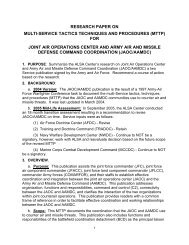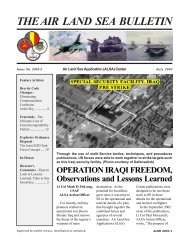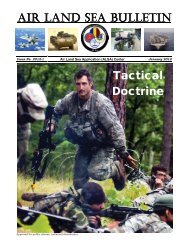AIR LAND SEA BULLETIN Attack the Network - ALSA
AIR LAND SEA BULLETIN Attack the Network - ALSA
AIR LAND SEA BULLETIN Attack the Network - ALSA
Create successful ePaper yourself
Turn your PDF publications into a flip-book with our unique Google optimized e-Paper software.
EXPANDING ATTACK THE NETWORK<br />
US Navy Petty Officer First Class Travis Tellez, an explosive ordnance disposal (EOD) technician with EOD Platoon 815, inspects a device<br />
during a mission to safely remove, transport, and destroy explosives stored at an Afghan National Army (ANA) compound in Farah City,<br />
Farah Province, Afghanistan, 27 December 2011. ANA forces, Provincial Reconstruction Team Farah, and <strong>the</strong> EOD platoon worked toge<strong>the</strong>r<br />
to safely destroy more than 250 weapons and more than 1,300 pounds of explosive material. (Photo by 1LT Mark Graff, USA)<br />
… it became<br />
apparent that<br />
attacking networks<br />
that<br />
funded, created,<br />
planned, and<br />
implanted IEDs<br />
was more effective<br />
and<br />
economical.<br />
By Scott Kinner<br />
To many observers, <strong>Attack</strong> <strong>the</strong><br />
<strong>Network</strong> (AtN) began, and is still most<br />
often associated with, counter-improvised<br />
explosive device (IED) efforts. Ra<strong>the</strong>r<br />
than spending time and energy in a<br />
classic competition between increasing<br />
or defeating armor; adding protection<br />
or increasing <strong>the</strong> size of IEDs; it became<br />
apparent that attacking networks<br />
that funded, created, planned,<br />
and implanted IEDs was more effective<br />
and economical.<br />
Within <strong>the</strong> Marine Corps, operational<br />
forces and formal learning<br />
centers recognized <strong>the</strong> basic premise<br />
behind AtN applied in a far broader<br />
sense than merely that of <strong>the</strong> counter-<br />
IED fight. Marine Corps leaders were<br />
not alone in coming to this conclusion.<br />
As <strong>the</strong> Marine Corps worked with <strong>the</strong><br />
ALSB 2012-2 4<br />
Army on counterinsurgency doctrine,<br />
offensive and defensive tactics, and<br />
o<strong>the</strong>r efforts, both services recognized<br />
when it came to networks, <strong>the</strong> joint<br />
force ―had been <strong>the</strong>re before.‖<br />
Indeed, from <strong>the</strong> birth of <strong>the</strong><br />
nation, through <strong>the</strong> Indian Wars and<br />
Cold War, <strong>the</strong> joint force always possessed<br />
an interest in networks – command<br />
and control (C2), air defense, economic,<br />
social, political, information,<br />
etc. From its origins in World War I<br />
to present-day operations in Libya,<br />
Air Force planners sought to understand<br />
industrial, communications,<br />
economic, and transportation networks<br />
and how <strong>the</strong>y could be pressured,<br />
degraded, and influenced. Navy and<br />
Marine Corps leaders sought to understand<br />
and affect trade, political, economic,<br />
military, and social networks<br />
by enlisting desert allies in <strong>the</strong> Barbary





